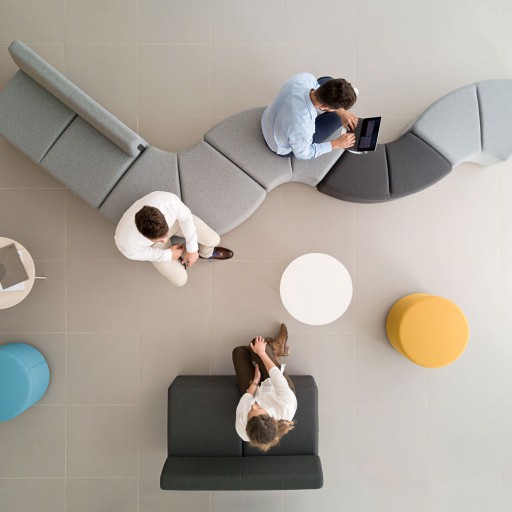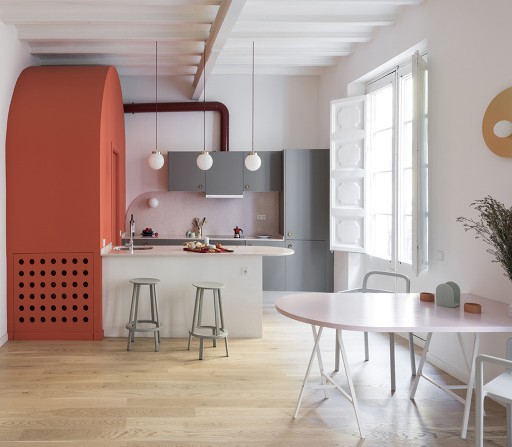In interior design, the idea of going natural and getting back to basics is being used in spaces now more than ever. Our concern for the environment and the impact of the climate crisis is pushing studios and companies to look for more sustainable and organic solutions that have a stronger connection to nature. The raw aesthetic is the perfect example of this, reflecting environmental awareness and the desire to live more responsibly by focusing on protecting unique features and taking care of the planet.
Ver esta publicación en Instagram
What are raw interiors?
Raw interior design is an eco-friendly approach that uses materials (mainly timber) that have undergone very little processing and have not been treated using artificial products such as varnishes, dyes, or enamels, making it feel like they have come into our home fresh from the forest or the field. Low-cost giants such as Ikea and Zara Home, as well as brands like Porcelanosa, are taking inspiration from raw design for their new collections. In 2021, Inditex decorated the entrance to their flagship store in A Coruña with a panel of chestnut wood that was four metres wide and two metres high. The piece, by Lugo-based basket maker Idoia Cuesta, had a huge impact on anyone that walked past it.
Ver esta publicación en Instagram
The beauty in raw materials
The ‘raw’ concept came to the design world via restaurants, with those looking to live a healthier lifestyle and reduce their impact on the environment choosing to include raw food in their diet. This meant 100% natural and organic ingredients that were consumed without being cooked or processed.
In design, the raw aesthetic is made up of similar elements: natural, untreated materials in all their untouched glory, showing off their inner beauty. They are unfinished and have a textured surface, making them raw to look at as well as touch.
The raw approach also includes recycling and reusing. Upcycling is very much at home in this type of decorating, too. But it’s not about neglect or carelessness. Rather, there is a strong focus on artisanal products that are in their natural state and have a strong sense of inhibition, but that have been created with care. For example, American designer Thomas Ptacek works with saved trees that had to be cut down for safety reasons or that fell because of a storm, using them to create furniture pieces.
Ver esta publicación en Instagram
Timber: the star of raw interior design
Timber is definitely the star of raw design. However, raw is not the same as rustic, even though people often confuse the two. The latter style also uses timber, but these surfaces are usually smooth, perfect, and shiny, with several layers of varnish and intense colours.
The raw aesthetic uses timber in a more authentic, pure, and original way, making use of the shapes created by the growth of the trees themselves. It’s all about bare, matte timber with all its knots, cracks, grains, and rough, uneven textures, unpolished edges and occasionally bark. Light colours such as white, beige, cream, earthy tones, and greys are used, with natural colour variations in the material forming part of the aesthetic.
Ver esta publicación en Instagram
Raw interiors feature raw timber such as uncoated timber boards, which are ideal for construction and furniture making because they are very robust. Finsa makes them in MDF and MDP in different formats and thicknesses. Another Finsa option for the raw aesthetic is greenpanel, a range of ultralightweight panels with raw edges and high durability, characteristics that create a great look with lots of personality. It’s used to make furniture, as well as bookshelves, movable panels, floating ceilings, display stands, and ephemeral architecture.
Wabi sabi: imperfection is perfect
Adolfo Domínguez said that “wrinkles are beautiful”. You could say that this is also the maxim the raw aesthetic, a style that doesn’t try to hide an object’s defects because they are, in fact, its best attributes. These imperfections make something that is truly authentic, giving it soul and character. Uneven or irregular shapes, scars left by the passing of time, the mark left on a wooden table by a wine glass, the hole in a tree stump. These are not mistakes. They are as natural as the moss that grows on a rock or a tree that grows sideways because of the wind’s force.
Ver esta publicación en Instagram
In Japanese culture, this is referred to wabi sabi. There is no direct translation for it, but the word wabi refers to the elegant beauty found in simplicity and sabi is the passing of time and the deterioration that it brings. Together, these terms create an aesthetic and metaphysical concept that encapsulates the imperfect, the incomplete, and the ever-changing. Projects by Belgian interior designer, collector, and antiquarian Axel Vervoordt are perhaps the best example of how this philosophy of perfect imperfection can be applied to interiors.
What types of materials are used in raw interiors?
As we’ve already mentioned, timber is the main feature of these spaces, but there are other common materials, too:
Distressed and oxidised metals as seen in this Varsovia apartment’s raw laminated steel bookcase featuring timber and marble by ParadowskiStudio.
Ver esta publicación en Instagram
- Unpolished stone seen here on this bathroom floor by Australian company CranmoreHome&Co.
Ver esta publicación en Instagram
- Natural fabrics and environmentally friendly fibres: in a ‘raw’ interior, there are usually textiles (e.g., cushions cover, plaid, curtains, and rugs) in natural, organic fabrics. These include heavy linen, a natural fibre that does not need pesticides and is biodegradable; fabrics featuring knots and frayed edges; cotton, another biodegradable, sustainable, and cheap option; natural wool that does not require the use of chemical products; hemp, which is pesticide-free and very durable; wicker; and natural cork derived from cork trees, another biodegradable, recyclable, and renewable source that can be turned into flooring.
- Wicker:
Ver esta publicación en Instagram
- Rug:
Ver esta publicación en Instagram
- Cushions and plaids:
Ver esta publicación en Instagram
- Tablecloths:
Ver esta publicación en Instagram
Sometimes a space needs textures that add dimension and that feel good to the touch. British artist Wycliffe Stutchbury achieved this by creating curtainz made from small tiles of European oak attached to a cotton structure, making a traditionally hard material feel soft.
Ver esta publicación en Instagram
There are also grainy weaves like bouclé, a type of thread with knots that is knitted into a thick, yet elegant and timeless fabric.
Ver esta publicación en Instagram
Plastic has no place in a raw-style space, and it’s being used less frequently in general because it is not biodegradable and is difficult to recycle, resulting in a large carbon footprint. However, some designers have used it successfully, including Dutch studio The New Raw (the name is no coincidence). They saw the potential in plastic waste generated at their facilities in Rotterdam and created the Ermis chair, printing it in 3D using a spiral thread of plastic, meaning no glue or toxic varnishes are required. Take a look at how they do it here:
How to create a raw interior
Raw interior design is characterised by simplicity and by its lack of garishness, making things feel cosy and balanced, transforming spaces and creating an atmosphere of calm and wellbeing. It’s all very hygge.
Ver esta publicación en Instagram
There must always be plants:
Ver esta publicación en Instagram
And accessories that fit the style perfectly, such as lamps made using natural fibres, copper, or zinc; baskets; artisanal porcelain vases, and glass vessels:
Ver esta publicación en Instagram
Ver esta publicación en Instagram
A combination of essential pieces as well as others that are more modern is another element of the raw aesthetic. Here are a few examples:
Ver esta publicación en Instagram
Ver esta publicación en Instagram
Those that are faithful to this style follow just one rule: don’t overdo it. Raw pieces are truly eye-catching, so there is no need to go overboard.
Ver esta publicación en Instagram
Ver esta publicación en Instagram
What do you think of the raw aesthetic? Do you think it’s the perfect balance between natural and contemporary styles? Tell us what you think on social media using #ConnectionsByFinsa.




